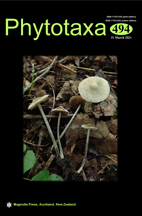Abstract
Allium toksanbaicum from South East Kazakhstan is described as a new species. Molecular markers reveal a close relationship to A. obliquum and some other central Asian species of the section Oreiprason. We investigated the phylogenetic relationship of the new species based on sequences of two chloroplast spacers (rpl32-trnL and trnQ-rps16) and the nuclear ribosomal DNA internal transcribed spacer (ITS) region. The new species is diploid with a chromosome number of 2n = 2x = 16. A detailed morphological description, illustrations and karyotype features of the new species are given. With its falcate leaves, the new species is very similar to A. carolinianum from the section Falcatifolia, but in the shape of the inflorescence and flowers it is very different from it. From A. obliquum it differs for the purple colour of flowers and filaments, as well as the presence of teeth at the base of inner stamens.

